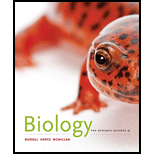
Biology: The Dynamic Science (MindTap Course List)
4th Edition
ISBN: 9781305389892
Author: Peter J. Russell, Paul E. Hertz, Beverly McMillan
Publisher: Cengage Learning
expand_more
expand_more
format_list_bulleted
Concept explainers
Question
Chapter 6, Problem 1ITD
Summary Introduction
To review:
The ∆G for the parent polypeptide and the mutated polypeptide binding to the protein.
Introduction:
The
Expert Solution & Answer
Want to see the full answer?
Check out a sample textbook solution
Students have asked these similar questions
↑
LED
Tt O
Tt e 0 ✓
B
>
FLORES DIology Second Semester Review
7. Chi Square Analysis: wild dumpy male x ebony wild female
F1:
All wild wild
F2:
142 wild wild males
52 wild ebony males
46 dumpy wild males
17 dumpy ebony males
151 wild wild females
47 wild ebony females
51 dumpy wild females
8 dumpy ebony females
What pattern of inheritance is observed for body color?
Autosomal recessive
Autosomal dominant
Sex-linked recessive
Sex-linked dominant
What are the genotypes of the parents in the P generation?
a.
XBYdd x XbXbDD
b. Bbdd x bbDd
c. BBdd x bbDD
d. BBX Y x bbXDY
How many flies in the F2 generation would you expect to express the dumpy wild phenotype?
a.
289.125
b. 97
c. 96.375
d. 293
4. This question focuses on entrainment.
a. What is entrainment?
b. What environmental cues are involved in entrainment, and which one is most influential?
c. Why is entrainment necessary?
d. Assuming that a flash of darkness is an effective zeitgeber, what impact on circadian
rhythms would you expect to result from an event such as the 2024 solar eclipse (assume
it was viewed from Carbondale IL, where totality occurred at about 2 pm)? Explain your
reasoning. You may wish to consult this phase response diagram.
Phase Shift (Hours)
Delay Zone
Advance Zone
Dawn
Mid-day
Dusk
Night
Dawn
Time of Light Stimulus
e. Finally, give a real-world example of how knowledge of circadian rhythms and
entrainment has implications for human health and wellbeing or conservation biology.
This example could be from your reading or from things discussed in class.
Generate one question that requires a Punnet Squre to solve the question. Then show how you calculate the possibilities of genotype and phenotype
Chapter 6 Solutions
Biology: The Dynamic Science (MindTap Course List)
Ch. 6.1 - Prob. 1SBCh. 6.1 - In thermodynamics, what is meant by an isolated...Ch. 6.2 - Prob. 1SBCh. 6.2 - Prob. 2SBCh. 6.2 - Distinguish between exergonic and endergonic...Ch. 6.3 - Prob. 1SBCh. 6.3 - How are coupled reactions important to cell...Ch. 6.4 - How do enzymes increase the rates of the reaction...Ch. 6.4 - Can enzymes alter the G of a reaction?Ch. 6.5 - Prob. 1SB
Ch. 6.5 - What is the difference between competitive and...Ch. 6.5 - Prob. 3SBCh. 6.6 - Prob. 1SBCh. 6 - The capacity to do work best defines: a metabolic...Ch. 6 - The assembly of proteins from amino acids is best...Ch. 6 - When two glucose molecules react to form maltose:...Ch. 6 - When glucose reacts with ATP to form...Ch. 6 - In the following graph: A represents the product....Ch. 6 - Which of the following methods is not used by...Ch. 6 - In an enzymatic reaction: a. the enzyme leaves the...Ch. 6 - Which of the following statements about the...Ch. 6 - Which of the following statements about inhibition...Ch. 6 - Which of the following statements is incorrect? a....Ch. 6 - Prob. 11TYKCh. 6 - Discuss Concepts Trace the flow of energy through...Ch. 6 - Prob. 13TYKCh. 6 - Prob. 14TYKCh. 6 - Prob. 15TYKCh. 6 - Prob. 16TYKCh. 6 - Prob. 17TYKCh. 6 - Prob. 1ITDCh. 6 - Prob. 2ITDCh. 6 - Prob. 3ITD
Knowledge Booster
Learn more about
Need a deep-dive on the concept behind this application? Look no further. Learn more about this topic, biology and related others by exploring similar questions and additional content below.Similar questions
- Briefly state the physical meaning of the electrocapillary equation (Lippman equation).arrow_forwardExplain in a small summary how: What genetic information can be obtained from a Punnet square? What genetic information cannot be determined from a Punnet square? Why might a Punnet Square be beneficial to understanding genetics/inheritance?arrow_forwardIn a small summary write down:arrow_forward
- Not part of a graded assignment, from a past midtermarrow_forwardNoggin mutation: The mouse, one of the phenotypic consequences of Noggin mutationis mispatterning of the spinal cord, in the posterior region of the mouse embryo, suchthat in the hindlimb region the more ventral fates are lost, and the dorsal Pax3 domain isexpanded. (this experiment is not in the lectures).a. Hypothesis for why: What would be your hypothesis for why the ventral fatesare lost and dorsal fates expanded? Include in your answer the words notochord,BMP, SHH and either (or both of) surface ectoderm or lateral plate mesodermarrow_forwardNot part of a graded assignment, from a past midtermarrow_forward
arrow_back_ios
SEE MORE QUESTIONS
arrow_forward_ios
Recommended textbooks for you
 Biology: The Dynamic Science (MindTap Course List)BiologyISBN:9781305389892Author:Peter J. Russell, Paul E. Hertz, Beverly McMillanPublisher:Cengage Learning
Biology: The Dynamic Science (MindTap Course List)BiologyISBN:9781305389892Author:Peter J. Russell, Paul E. Hertz, Beverly McMillanPublisher:Cengage Learning Human Heredity: Principles and Issues (MindTap Co...BiologyISBN:9781305251052Author:Michael CummingsPublisher:Cengage Learning
Human Heredity: Principles and Issues (MindTap Co...BiologyISBN:9781305251052Author:Michael CummingsPublisher:Cengage Learning BiochemistryBiochemistryISBN:9781305577206Author:Reginald H. Garrett, Charles M. GrishamPublisher:Cengage Learning
BiochemistryBiochemistryISBN:9781305577206Author:Reginald H. Garrett, Charles M. GrishamPublisher:Cengage Learning Human Physiology: From Cells to Systems (MindTap ...BiologyISBN:9781285866932Author:Lauralee SherwoodPublisher:Cengage Learning
Human Physiology: From Cells to Systems (MindTap ...BiologyISBN:9781285866932Author:Lauralee SherwoodPublisher:Cengage Learning

Biology: The Dynamic Science (MindTap Course List)
Biology
ISBN:9781305389892
Author:Peter J. Russell, Paul E. Hertz, Beverly McMillan
Publisher:Cengage Learning

Human Heredity: Principles and Issues (MindTap Co...
Biology
ISBN:9781305251052
Author:Michael Cummings
Publisher:Cengage Learning

Biochemistry
Biochemistry
ISBN:9781305577206
Author:Reginald H. Garrett, Charles M. Grisham
Publisher:Cengage Learning

Human Physiology: From Cells to Systems (MindTap ...
Biology
ISBN:9781285866932
Author:Lauralee Sherwood
Publisher:Cengage Learning


Information Storage and the Brain: Learning and Memory; Author: Professor Dave Explains;https://www.youtube.com/watch?v=PQDiUKwXLVI;License: Standard youtube license